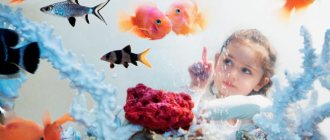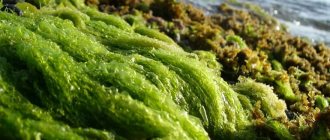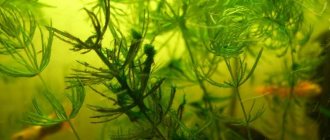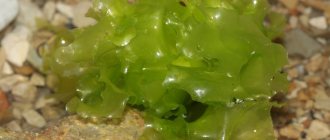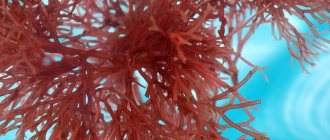Structural features of blue-green algae
Blue green algae are large bacteria that can be found singly, in groups, or in threads. Their peculiarity is the ability to carry out true photosynthesis (release oxygen into the aquatic environment in the light). They, unlike euglenoid and pyrophytic algae, do not have flagella and a characteristic mucous membrane, grow quickly and cover the surface on which they are attached with a dense layer. In addition, this cell is a typical prokaryote. It does not have a nucleus or internal organelles.
In nature, it is part of natural phytoplankton, a participant in many symbioses in the water element.
Depending on growing conditions, they can change their color: from light green to dark purple. This coloring is obtained due to the prevalence of one of the main participants in photosynthesis: chlorophyll and phycocyanin. The shade depends on their percentage.
Dense colonization of aquarium water by such microorganisms leads to a loss of transparency, the acquisition of an unpleasant musty odor, and the death of cultivated plants and algae, as well as existing fauna.
Due to their structure, they grow quickly on hard surfaces, forming dense thick layers. Mucus almost always forms around such organisms. This is the protective property of cyanobacteria to resist adverse environmental factors. So, in nature, when a reservoir dries out, mucus prevents bacteria from quickly dying. And when they get back into the water, they quickly restore their viability.
Chroococcus
It is often found in silt, among aquatic plants and mud, and is involuntarily introduced into algae cultures along with other, larger material. It is more accurate to look for it in sphagnum peat bogs, in depressions with water among the depressions of the moss carpet. When searched under a microscope, it is easily recognized among other similar organisms due to its bright bluish color. More often it occurs in the form of two identical cells, separated by a thin membrane and surrounded by a common, very thick gelatinous layer. The entire organism has a round or elliptical shape. When cells reproduce, they move away from one another; a transverse partition appears in the jelly separating them, and the ball breaks up into two single-celled ones. Then, in each of the young chroococci, cells divide into two, and the cycle of its development returns to the starting point. In other cases, when division proceeds faster, the chroococcus can become four-celled and only then split into individual cells. There are no more cells than four in one colony.
What options exist?
Over the 3 billion years of its existence, blue-green algae have formed many modifications.” Today more than 2.5 thousand of their species are known. Among them:
- gleotrichia;
- anabena;
- oscillator.
For gleotrichia, the natural habitat is reservoirs with salty moving water, in which they can live on obsolete parts of vegetation.
Anabena can be found in swamps and ponds with a clay bottom and even in puddles after rain.
Oscillators prefer stagnant water, often enveloping the surfaces of drowned objects, but are also found on the surface of reservoirs.
Numerous photos of “blooming” reservoirs reflect the result of the colonization of cyanobacteria. In this case, the ecological balance is disrupted. Plants stop growing and are poorly strengthened, fish practically suffocate from the presence of harmful chemicals in the water - waste products of the pest.
Attention! Toxic!
Cyanobacteria produce dangerous substances - toxins. You can even feel them! Geosmin, for example, is the cause of an earthy odor that should not be present in water.
And algotoxins are a key indicator of a polluted reservoir. They literally poison the water, making it unsuitable for anything - neither for drinking nor for swimming.
If a person swims in a flowering pond, he will get irritation to the mucous membranes of the nose, eyes and skin. This is especially dangerous for allergy sufferers, children, as well as people with diseases affecting the nervous and respiratory systems, skin, kidneys and liver. And in the USA, there was once a case when a boy, who took a swim in a massively blooming pond, died suddenly.
Imagine yourself in a room: advice for people with low self-esteem
It’s not always a desire to make money off people: why do they sell us fish covered in ice?
How to eat cottage cheese correctly so that the body can absorb all the calcium from it
Biological characteristics
All species feed in a phototrophic manner, similar to kelp. However, there is evidence that the bacterium can also feed mixotrophically, i.e. mixed. It practically absorbs ready-made organic substances throughout its entire surface, which is why it grows.
Algae are not capable of reproducing sexually. They are characterized by a filamentous method of growth, known as vegetative. From several initial elements, entire thickets quickly form, often entangling cultivated plants, like a cobweb.
All types of cyanobacteria have in common their high vitality and the ability to quickly recover.
The pest is also resistant to some methods of disinfection. It can resist popular salting, adding a few drops of brilliant green to water or other similar effects. To fight, natural antibiotics and special means for disinfecting water and aquarium surfaces are needed.
Gomphosphere
Gomphosphere forms dense, irregularly spherical colonies of cells that are wider outward and narrowed inward, with the mucous membrane of the cells from the narrowed end extended into a small stalk. It floats in masses on the surface of the water or at shallow depths and in the Neva basin often causes water blooms.
Colorless mucus binds all the cells of the colony into a dense ball devoid of any cavity. The cells lying in the central part are almost spherical in shape. As the entire colony grows, it often produces lobed protrusions, giving it an irregular shape. “Pseudovacuoles” are conspicuous in all cells of the gomphosphere and, being lighter than water, increase the swimming ability of its colonies. Gomphosphere cells divide longitudinally; they do not have any special reproductive organs: in the fall they lie on the bottom, and in the spring they float to the surface again.
How can you tell if there is cyanobacteria in your aquarium?
Blue-green algae, belonging to the kingdom of prenuclear algae (or crushed algae), have gone through such a long historical development path that they have learned to adapt to the most negative conditions of existence. Many of them are unacceptable to other plants. They can grow in water:
- contaminated with chemicals;
- heated up to 93°C;
- with signs of rotting;
- contaminated with organic matter to levels exceeding acceptable standards for life.
Bacteria are able to survive in ice and grow on completely lifeless surfaces.
If blue green algae appears in an aquarium , this can initially be noticed when changing the water. After draining a few liters, you notice an unpleasant odor coming from inside. The leaves of large plants become slightly slippery and soft, gradually changing their color to a duller color.
Later, you pay attention to a strange mucus that, over time, reduces the transparency and chemical composition of the aquatic environment. At the same time, a green coating appears on the surfaces of stones, grottoes, various supports and decorative items. It tends to turn into a dense crust of algae. You can verify its presence by lightly scratching it with your fingernail: it should come off in large flakes.
Measures not taken in time guarantee the complete destruction of the existing biocenosis. The plaque will cover the walls and bottom of the aquarium, settle on the surface of the soil and turn into a dense, air-tight coating.
Gleocapsa
The name Gleocapsa refers to the particularly characteristic structure of the gelatinous membranes of this algae, which forms mucous accumulations in puddles, on damp soil, on damp rocks and old damp walls, on damp bark, stumps, etc. It tolerates life well in laboratory cultures, sometimes developing in masses. Gleocapsa cells are sometimes very small, spherical, with thick protective membranes. They divide equally in any direction, but the membranes of the mother cells remain intact, and after several successive divisions a rather complex colony appears with a system of intercalary membranes nested one inside the other. In this case, all cells do not always divide evenly, but each has as many membranes between itself and the outside world as it is the product of successive divisions. Such a system, of course, perfectly protects cells from evaporation; when there is an abundance of mucus, the membranes mucus, liquefy, and the cells fall out on them, then forming several new colonies.
The cells of most Gleocapsa species are blue-green in color, although often pale; in some species they are purplish-red, in others they are yellow or brownish. The shells of some species are colorless, while others are red, yellow, blue, purple or blackish.
What contributes to this process?
A bacterium brought from outside into a safe water home requires:
- intense sunlight or artificial light;
- temperature rise above 24°C;
- rare water changes;
- low level of aeration;
- extended lighting period;
- the presence of accompanying (bacterial) flora: various microbes, protozoa or viruses.
A factor contributing to the growth is regular sediment from uneaten food, especially of a biological nature.
Hormogoneae
Organisms consisting of cells that divide only transversely and therefore form filamentous colonies; reproduction by hormogonies.
1. The threads are all made of identical cells, not branched, family Oscillatoriaceae.
2. Filaments with false branching, consisting of active cells and heterocysts, family Scytonemataceae.
3. Threads without false branching, but also with heterocysts, family Nostocaceae.
4. Threads with heterocysts, active cells and hair-like endings, family Rivulariaceae.
Anyone who has ever been on the banks of rivers or lakes, near limestone cliffs, or even examined pieces of limestone taken out of the water, broken off or rolled into pebbles, will not be difficult to notice another widespread organism, namely Hyella fontana, which, with its acidic secretions, dissolves lime carbonate and penetrates quite deeply into stones, as well as into shells. On the rapids of the Meta and Volkhov rivers, blue-green carpets from Hyella color the limestone slabs, often covering many hundreds of square meters. Hyella cells are partly folded into short filaments with gelatinous cases, partly they form small plates or are arranged clearly. Their primary threads stretch horizontally in the limestone, while the secondary threads rise vertically. Reproduction is partly by cell division, partly by the proliferation of some stronger cells, after which their protoplast is divided into parts, which, rounded and breaking the shell, come out. Such cells are already special reproductive organs, which is why we consider them spores, and since they remain active all the time and immediately upon exiting begin to grow further, then we. we attribute them to the so-called conidial spores or, in short, simply conidia. By gradually dissolving the lime, Hyella and other similar organisms play a common role in nature, converting the calcium of limestones into soluble salts necessary for the nutrition of all green plants. These organisms are called "boring algae."
How to try to get rid of an unwanted guest?
How to approach such a problem? After all, we often hear that water has sufficient cleaning power to cope with its own contaminants. To a certain extent this is true, but only applies to large natural bodies of water. Artificial conditions, and, most importantly, a small amount of water, will not make it possible to defeat such an uninvited guest.
After all, it does not need food, it is an autotroph, and reproduction occurs quickly and easily.
You can try to defeat the newly emerging blue-green algae, including oscillatorium , with the help of bottom orderlies - ancistrus. These beloved creatures belong to the catfish species, which naturally clean surfaces in their common aquatic home. They are not only funny, but also useful.
Blue green algae are bacteria that need to be combated in several ways:
- create conditions contrary to the algal world;
- determine and implement a water disinfection method;
- thoroughly rinse the soil and clean all affected surfaces;
- disinfect the plants and rinse them thoroughly in cold running water;
- take measures to ensure that the blue or greenish representative of single-celled algae does not reappear.
Step by step, the essence of these actions of the aquarist comes down to the following.
- Remove as many inhabitants from the affected aquarium as possible;
- If possible, remove objects that are important for the growth of cyanobacteria;
- Change at least half of the water volume, replacing it with fresh, oxygen-enriched water;
- Well-rooted plants can be left untouched, but small and floating ones should be removed and sanitized in an accessible way;
- Add an antibiotic to the water, for example, erythromycin at the rate of 3-5 mg per 1 liter;
- Completely shade the aquarium and leave it without access to light for 72 hours;
- At the end of the exposure, change a third of the water again and open it to light.
Before repopulating the fish, it is worth observing how effectively the remediation was carried out. If there are traces of cyanobacteria, it is better to repeat the procedure in time.
With such actions, you can simultaneously fight not only blue-green algae , but also other harmful phenomena in the aquarium, such as xenococus.
For small aquariums, general recommendations cannot be considered optimal. Their main difference is that changing some of the water, the amount of which is already limited, will not be enough. For such a case, it is proposed to get rid of the plant pest using hydrogen peroxide. You need to determine its dose based on the volume of the aquarium: 20-25 ml of peroxide is added proportionally to 100 liters. Most likely, the treatment from oscillators will not end at once, and after 24 hours it is advisable to repeat it.
Clathrocystis
Clathrocystis is apparently the simplest of all blue-green algae. Its small cells are spherical, with blue-green granular contents, in which pseudovacuoles can form. The mucus secreted by the cells holds them back long after division, binding masses of cells into irregular clusters lying on the bottom in the silt, between other algae, on damp soil, etc. They grow in masses in laboratory aquariums, and are especially abundant between glass and soil , placed on the bottom of the aquarium, but always move to the illuminated side of the vessel. Their films are typically blue-green and can serve as an object for demonstrating this color with the naked eye.
Having become acquainted with the main, most typical representatives of the cyanaceae type, we can now derive their general characteristics and construct a division into groups.
All the representatives we examined had in common the following features:
1. Blue-green color, indicating the presence in the cells, along with chlorophyll, of a blue pigment - phycocyan.
2. Division of the cell into a central pale colored part and a brighter colored peripheral part in the absence of a nucleus and chromatophore. Otherwise, the protoplast is divided into a central body and a colored part.
3. Reserve substances in the form of glycogen, cyanophycin and anaenine.
4. Division of the integument into a thin, chitin-impregnated primary shell and a layer of mucus or jelly.
5. Reproduction by simple division.
6. General cell mobility in the absence of visible organs of movement.
7. In higher representatives - reproduction of colonies through the formation of hormogonia and resting cells.
All these are common features characteristic of the cyanogen algae class as such. The division of this class into subordinate groups can be constructed on the following grounds:
